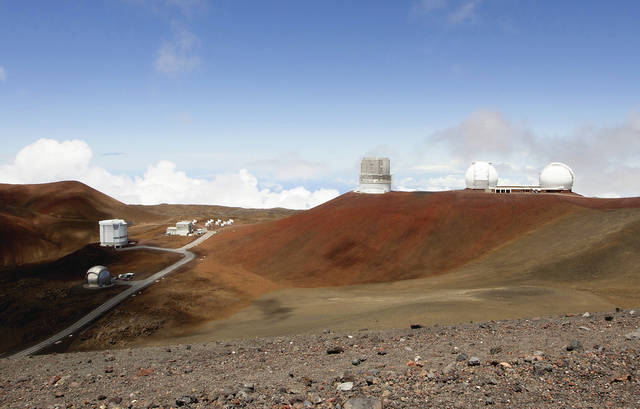The University of Hawaii’s Board of Regents adopted a resolution Thursday in Honolulu stating it affirms its commitment to the “collaborative stewardship” of Mauna Kea and its resources.
The resolution doesn’t mention Mayor Harry Kim’s proposal for a “Mauna Kea peace park,” but says it directs the university, which manages the 11,288-acre Mauna Kea Science Reserve, to “collaboratively build a global model of harmonious and inspirational stewardship that is befitting of Mauna Kea.”
UH’s master lease for the science reserve, home to 13 telescopes and the proposed site of the Thirty Meter Telescope, ends in 2033.
The resolution states the university should return 10,000 acres to the state, as requested by Gov. David Ige, and pursue a new lease for the remaining acreage needed to continue the “viability of astronomical research and education in the state.”
It also says the university should make it a priority to “meaningfully increase the engagement” of Native Hawaiian and other Hawaii Island students in the area of astronomy and celestial navigation.
The vote followed testimony that mainly focused on the TMT project and development of telescopes on the mountain. Those who oppose TMT spoke against the resolution.
“When I read this resolution, it feels disingenuous,” said Kamana Beamer, UH associate professor of Hawaiian studies, who is from Waimea. He urged the board to think more carefully about the measure.
“The trouble on Mauna Kea is not culture versus science,” Beamer said. “That’s a complete fallacy. … It’s about scale of development. It’s about supporting the largest telescope until a larger one is built.”
Malia Martin, who testified in support, said UH’s Office of Mauna Kea Management needs to be more responsible, but she doesn’t see Hawaiian culture as being in conflict with the telescopes.
“Stargazing is from Hawaii, stargazing is Polynesian,” she said. “… It’s our cultural birthright to practice stargazing and lead the world for this.”
A UH spokesman said about 28 people testified while 29 others submitted written testimony.
Ige said in a written statement that he is pleased that UH “affirmed its intention to take action to strengthen the collaborative stewardship of Mauna Kea and its resources. I look forward to working with the university and its partners to make meaningful changes that further contribute to the co-existence of culture and science on this special mountain.”
Another follow-up audit of UH’s management of the mountain released in July found it had partially completed four of the eight recommendations from the last report in 2014. One of the partially completed items was drafting administrative rules.
The report says Ige, who must authorize hearings on draft rules, temporarily halted the process. A proposed fee schedule for commercial tours hasn’t been drafted because those are intended to be done at the same time as the administrative rules, the report says.
The document also says UH is targeting December for completing management actions in the Comprehensive Management Plan. The 2014 audit recommended those be done no later than the end of 2016.
The state Board of Land and Natural Resources will hear oral arguments on a hearings officer’s recommendation in favor of TMT receiving a land use permit Sept. 20 in Hilo. Exceptions to hearings officer Riki May Amano’s order were filed Monday.
Email Tom Callis at tcallis@hawaiitribune-herald.com.



